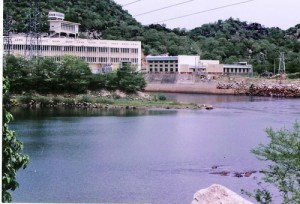A team of four Nigerian experts that went on a fact-finding mission to the Lagdo Dam in Cameroon has been denied access to the facilities by local officials.

On an instruction to obtain relevant information and hydrological data with respect to releases from the dam that led to the death of about 15 persons and the submersion of some 250 villages, the four-man team from the Upper Benue River Basin Development Authority (UBRBDA) and Nigeria Hydrological Service Agency (NIHSA) however met a brick-wall in the course of its assignment.
The team comprised Abubakar Mu’azu (Deputy Director, Operations at UBRBDA), John Shialsuk (Deputy Director, Hydrology & Hydrogeology at NIHSA), Ahmed Jalingo (Principal Technical Officer, Hydrology at UBRBDA) and Ahmed Isa Mbamba (Information Officer at UBRBDA).
Penultimate Sunday on its way to Cameroon, the team observed extensive flooding at Garoua along the River Benue, but it was denied access to the dam and other relevant information. The dam manager attributed the development to the fact that he had no authority to allow access to the facility or give any technical information. River Benue is the second largest river in Nigeria, second to the Niger.
He, however, disclosed that there was no rainfall during the past five days; that the two spillway gates of the dam were opened as well as the fact that power generation was in progress; that Garoua and Lagdo towns (located downstream of the dam) were extensively flooded; and that only a third of the dam inflow was being released.
The Nigerian team was told to, in the future, observe proper diplomatic procedure before being granted access to the dam facilities as well as other relevant technical information.
According to the foursome, the level of devastation at Garou by the flood is more severe than the Nigerian side of the border. Measurements taken on Monday, August 27, 2012 showed the water level at Jimeta Bridge at 163.486 m.a.s.l. (or metres above mean sea level).
“Moreover, the flood level so far is far below the 1070 incident when Lagdo was not in existence. In view of the foregoing, the Nigerian community should expect progressive increase in water levels,” disclosed the team.
Besides the immediate evacuation of residential settlements (and eventually their permanent relocation) along the River Benue flood plains, the team suggested further collaboration by Nigerian authorities with the Cameroon government to fashion out ways of forestalling future occurrence.
The Lagdo Dam is located on the Adamawa Plateau of the Northern Province of Cameroon, which shares border with the north-eastern Nigerian states of Borno, Adamawa and Taraba.
The dam’s primary outflow is River Benue, which takes its source from Adamawa Plateau (in Cameroon) and flows through the lowland elevations of Adamawa, Taraba and Benue states before meeting River Niger in Lokoja, Kogi State.
The steep elevation of the plateau apparently enhanced the flow of the released water from the dam, inundating lowland communities of north-eastern Nigeria especially those located within the River Niger drainage basin.
Indeed, the cascading waters from the reservoir snuffed out lives, disrupted socio-economic activities, led to environmental degradation as well as large scale ecological dislocation.
The Cameroonian High Commission in Nigeria has warned that if the trend of heavy rainfall experienced this year continues in the next few weeks, more water will be released from the reservoir till October.
Meanwhile, the National Emergency Management Agency (NEMA) has disclosed that officials at its North East Zonal Office are on ground and working with the respective State Emergency Management Agencies (SEMAs) to compile assessment reports, establish Internally Displaced Persons (IDP) camps, and provide necessary relief materials and first aid in collaboration with NEMA humanitarian partners.
Head of NEMA, Mohammed Sani-Sidi, said: “Reports reaching us from Adamawa State have confirmed that, out of the 10,524 affected persons in 10 Local Government Areas, 15 people have lost their lives.
“Based on assessment reports so far received, approval has been granted for further delivery relief intervention while the agency will soon commence working with the relevant authorities for the rehabilitation of affected communities.”
Chairman, Adamawa State Flood Disaster Committee, Kobis Ari, called on the government of Nigeria to enter into a bilateral agreement with the Cameroonian government on how to avert the yearly disaster caused by Lagdo Dam to the people of the state.
He said: “We received a letter from Cameroun Republic last Friday to notify us of their intention to release water from the Lado Dam which is located at the upper end of River Benue. A day after the water was released, the Cameroun Republic did not give us enough time to communicate with our people to vacate the flood-prone areas.”
Ari added: “Since the 1958 flood disaster that killed many people, this is the worst that has happened in Adamawa State. Many schools, hospitals, government buildings and over 250 villages have been submerged by the flood.”
To avoid an outbreak of disease as a result of the flood, he said that medical workers have been deployed to all the affected areas to provide free medical services to the victims.
“The state Emergency Management Agency have also deployed its workers to various areas affected by the flood to provide the victims with food, blankets and other things they need to survive before the Federal Government arrive with its assistance,” he stated.
